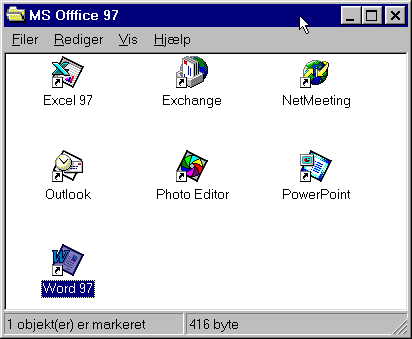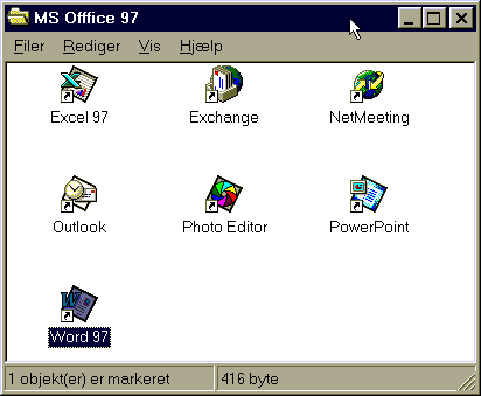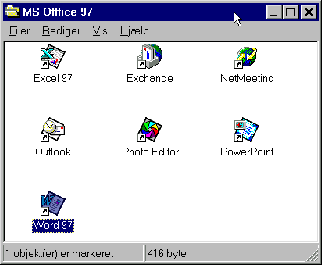Tip of the
month from
PRC
July 1999
Handling raster images in
MS Word 97
Updated 18 January 2000:
New absolute/relative path info + more advises.
Published 1 July 1999


We accept Mastercard/Eurocard/Maestro/JBC!
Tip of the month is edited by Peter Ring, PRC (Peter Ring Consultants,
Denmark)
- consultants on how to write user
friendly manuals
.
If you have corrections,
better texts or suggestions for improvements,
please let me know.
Thanks to...
...Marilyn FlaxMarilyn Flax, Presence Online, Australia, for the
idea to this month's tip.
...David D'Anjou, Canada, for improvements suggestions.
Contents
Old related tips:
9711
: How to use vectorised images in MS Word (6/7/95). Updated 11 December 1997.
9806
: Resizing of bitmaps.
9807
: Graphical formats survey.
Background
Microsoft Word
has been heavily criticized for a lot of things, often with good reason.
And because of the enormous initial problems, MS Word 97 got a very bad reputation,
which to a large extend has been solved by the later bugfixes, mainly SP1.
From my viewpoint, MS Word 97 is still not unproblematic, but it is no longer
as bad as it's reputation, and one of the major problems -- large documents
-- has been significantly reduced.
The problems
with the old MS Word internal raster image format
One of major problems
for technical writers (before MS Word 97 = MS Word 8) was its enormous stability
problems with very large document files. That was typically the case when
the document included many large raster images ("bitmaps"), e.g. software
manuals with screenshots. One of the reasons for the large files was, that
all images was stored internally in the Word document as an uncompressed
.WMF format + the original file format (e.g. TIF), and that took up a lot
of file space. Microsoft's recommendation was to use the "Master document"
feature, but using the master document feature was complicated and even more
unstable. The users consequently had three options, only:
-
Split the document up in subdocuments
, which could be contained in the computers RAM without using Windows' "virtual
memory" (using the harddisk as a temporary RAM). In this case, MS Word was
fairly stable.
- Insert
all images as linked objects without embedding them. In this way, the
size of the document could be kept low, and you could work with documents
of several hundred pages without the traditional size problems. But then
you had the problem with "full path" (the image was embedded as e.g. c:\MyDocs\MyProject\images\image1.tif),
making it difficult to transfer the document to another computer. The solution
could be using relative path (the image was embedded as e.g. images\image1.tif),
but than made it necessary to open the document using the "Files/Open" menu
instead of the various easier methods offered.
- Switch
to another application programme without this problem. Most techwriters
selected Adobe FrameMaker. But as MS Word was most often the internal company
standard for all other text applications, this could give some problems with
proofing, minor changes, etc.
The new embedded raster image format in MS Word 97
MS Word 97 use a new internal
format for embedded images, solving a lot of these problems, but also introducing
some new problems. The new internal format is a heavily compressed, up to
24 bit colours format, meaning significantly smaller files! And the
original file is no longer stored with the document either. This means...
- You can now use MS Word for
much larger documents with lots of raster images, e.g. screenshots.
- You save a lot of harddisk
space.
- It doesn't matter which
original format (BMP, TIF, GIF, etc.) you use for the image. The size of
the Word file will be the same if the content, number of pixels and number
of colours are the same.
If you zip the documents for distribution (or use another compression system),
the compressed file is only marginally smaller than the equivalent MS Word
6/7 file, because the raster images is already compressed.
The old advice for screenshots
is still valid: Shoot them on a 256 colour -- or even better a 16 colour
-- screen. If you use saved files, use GIF, which reduces the number of colours
to 256 or less with a lossless compression. Never use .jpg for ordinary screenshots;
they take up more space because they use 24 bit colours, and the lossy compression
significantly decreases the quality of a screenshot.
You can still use linked image
files without embedding for further file size reduction. When using linked
image files, the linked information stored in MS Word is now:
- relative path only
if the path to the linked image is in the same directory or below.
- absolute path if
the linked image is in a directory, where you need to go up in the directory
chain.
There are no more problems with
not using "Files/Open" for opening the file.
Problems with the new format and their solutions
As long as you stick to the original
image in MS Word 97 - no problems!
But if you want to modify
the image (e.g. using Paint Shop Pro), or you need it in a specific format
for another application not using OLE (e.g. a CMYK TIF for PageMaker) you
very quickly discover a lot of problems.
Let's take an example. In the
MS Word 97 document you have inserted the following 412x339 pixel screenshot:

Try to copy it (Ctrl-C) and
paste it into any raster image editor, e.g. Paint Shop Pro (PSP), and you
will get this ugly result:

As you see, it has got new colours,
and a new size (481x396 pixels). The new size has distorted the letters,
see e.g. the E in "Excel". Resizing it to 412 x 339 will even further distort
the letters.
But don't despair! Here is what
to do if you don't have the original screenshot - a bit complicated, but
it works:
- Set the image to 128% size
(Format/Image/Size). If this makes it too large, copy it to a new temporary
document with another paper size, which can contain it.
- Double-click the image in
MS Word which opens the MS Word image editor.
- Copy the image from there
to your raster image editing programme (e.g. PSP). If you did NOT resize
, the result would have become this 322x265 pixels image -- and 412/322 =
1.28 = 128%:

- Close the the MS Word image
editor, and press Ctrl-Z twice to undo the transformation to the internal
MS Word metaformat and the resizing.
If the size is not correct you
may experiment with the image size in point 1, repeating step 1 to 4. To
find the correct scaling (here 128%) you can
- Perform step 2 to 4 above
on the unscaled image.
- Temporarily insert the image
from point 3 above in the MS Word document
- Then calculate the ratio
as the ratio between the width of the original image and the width of the
reduced image (Format/Image/Size).
- You may need to experiment
a bit with the last decimal (e.g. use 127.9% instead of 128%) to get the
optimal result.
If you disagree
with these ideas - or have other relevant points, experiences, or ideas +/-,
please e-mail me!
Ideas
for new "Tip of the month" subjects are VERY welcome, too!
Go to
last month's tip
.
Go to a list of old tips
.
Return to the User Friendly Manuals' homepage
.
Free update service
Click here
if you want to receive an e-mail whenever this website is updated with
major new information, e.g. with a new "tip of the month" or a new interesting
link. The e-mail will briefly describe the content of the update.
.
.
.
.
.
.
.




